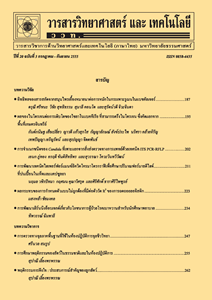การประเมินลักษณะทางสัณฐานวิทยาของเมล็ดและปริมาณสารประกอบไขมันของข้าวโดยใช้การวิเคราะห์หลายตัวแปร
Main Article Content
Abstract
Genetic diversity of rice is important for rice breeding strategies. The objective of this study was to evaluate rice grain morphological characteristics, α-tocopherol, γ-oryzanol in 81 rice germplasms compared with KDML105 and RD6, by using multivariate analysis including statistical analysis, principal component analysis, and cluster analysis. The results indicated that rice germplasms were significantly different for all traits. A large variation among genotypes was found for rice grain morphological characteristics (7.72-30.99 %), α-tocopherol (49.82 %) and γ-ryzanol (23.3 9%). In addition, the principal component bi-plot and clustering analysis based on rice grain characteristics were clustered rice germplasms into 9 groups. According to clustering analysis based on lipid compounds contents, 83 rice germplasm were distinguished to 9 groups. The highest α-tocopherol and γ-oryzanol contents group comprised 14 genotypes including Sun-Pa-Thong, Nang-Boon-Ma, Khao-Saw-U-Don, Pah-Kheng, Chao-Pa-Thum-Ma, Rean-Thong, Luang-Boon-Ma, Khao-Haw, Hom-Saeng-Thong, Khao-Hom, E-Daeng, Khao-Chao-Ra-Tree, LG2751 and Hom-Thung 1. As the result, this study can be useful for the rice germplasm selection and breeding of rice varieties with high nutraceutical lipid compounds in the future.
Article Details
References
Liu, R.H., 2007, Whole grain phytochemicals and health, J. Cereal Sci. 46: 207-219.
Mira, N.V., Massaretto, I.L., Pascual C.S. and Marquez, U.M., 2008, Comparative study of phenolic compounds in different Brazilian rice (Oryza sativa L.) genotypes, J. Food. Compost. Anal. 22: 405-409.
Thai Rice Exporters Association, Rice Production, Available Source: https://www.thairiceexporters.or.th/production.htm, December 20, 2018. (in Thai)
Thitiprasert, W., Jaichagun, M., Makrua, T., Thongjuaphet, P., Raksasin, S., Deeman, A. and Wuttiyano, C., 2011, Rice Breeding Database: Rice Research Institute and the National Plant Protection Bureau Department of Agriculture, Agricultural Cooperative Assembly of Thailand Limited, Bangkok, 682 p. (in Thai)
Harlan, J.R., 1992, Crops and Man, 2nd Ed., American Society and Agronomy, Crop Science Society of America, Madison, WI., 284 p.
Oka, H.I., 1988, Origin of Cultivated Rice, Japan Scientific Societies Press, National Institute of Genetic, Misima, 254 p.
Khavari, K.S., Mostafavi K., Zandipour E. and Heidarian A., 2011, Multivariate analysis of agronomic traits of new corn hybrids (Zea may L.), Int. J. Agri. Sci. 1: 314-322.
Phodjanawichaikul, P., 2017, Characteristic and quality determination of Thai rice with multivariate analysis, Songklanakarin J. Plant Sci. 4(2): 56-65. (in Thai)
van Beuningen, L.T. and Busch, R.H., 1997, Genetic diversity among North American spring wheat cultivars: III. Cluster analysis based on quantitative morphological traits, Crop. Sci. 37: 981-988.
Madee, P., Theerakulpisut, P., Sanitchon, J., Lontom, W., Pattankul, W. and Pengrat, J., 2014, Evaluation of salinity and drought tolerance in landrace colour rice genotypes at seedling stage using multivariate cluster analysis, Thai J. Bot. 6(Suppl.): 211-218. (in Thai)
International Rice Research Institute, 2002, Standard Evaluation System for Rice (SES), International Rice Research Institute (IRRI), Los Banos, 56 p.
Butsat, S. and Siriramornpun, S., 2010, Antioxidant capacities and phenolic compound of the husk bran and endosperm of Thai rice, Food Chem. 119: 606-613.
Ismail, M., AL-Naqeeb, G., Mamat, W.A.A., and Ahmad, Z. 2010, Gamma-oryzanol rich fraction regulates the expression of antioxidant and oxidative stress related genes in stressed rat’s liver, Nutr. Metab. 7: 1-13.
Goufo, P. and Trindade, H., 2014, Rice antioxidants: phenolic acids, flavonoids, anthocyanins, proanthocyanidins, toco pherols, tocotrienols, γ-oryzanol, and phytic acid, Food Sci. Nutr. 2: 75-164.
Joralee, A., Banteng, P. and Kaewpradit, W., 2013, Evaluation of agronomic traits and gamma oryzanol content in black glutinous rice grown under upland condition, Khon Kaen Agric. J. 41(1): 618-623. (in Thai)
Boodseephum, P. and Wongtamee, A. 2017, Morphological diversity and cluster analysis of local rice varieties from lower north region, pp. 343-348, 13th Naresuan Research Conference, Phitsanulok. (in Thai)
Kajonphol, T., Paowsrakoo, N. and Sangsiri, C., 2012, Diversity of local upland rice varieties in Kanchanaburi province, Agric. Sci. J. 43(Suppl. 2): 601-604. (in Thai)
Thamwongsa, T., Sanitchon, J., Meesawat, A. and Itharat, P., 2012, Morphological and anatomical characters of lowland-black rice grains in the Northeast of Thailand, KKU Sci. J. 40(4): 1138-1148. (in Thai)
Shen, Y., Jin, L., Xia, P., Lu, Y. and Bao, J., 2009, Total phenolics, flavonoids, antioxidant capacity in rice grain and their relations to grain color, size and weight, J. Cereal Sci. 49: 106-111.
Juliano, B.O., 1997, Rice lipids, II Riso. 26: 3-21.
Boonsit, P., Pongpichan, P., Julsrigival, S. and Karladee, D., 2010, Gamma-oryzanol content in glutinous purple rice landrace varieties, CMU. J. Nat. Sci. 9(1): 151-157.


